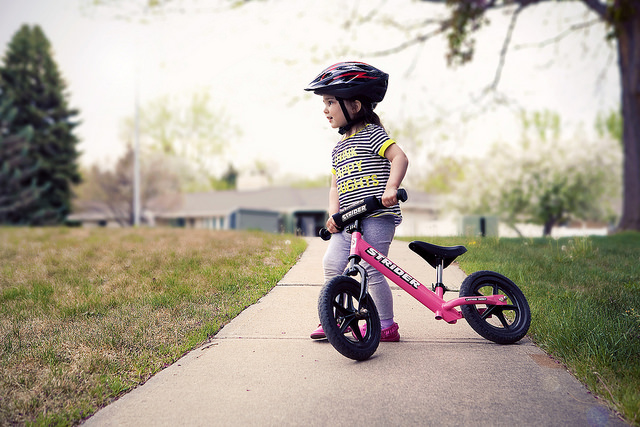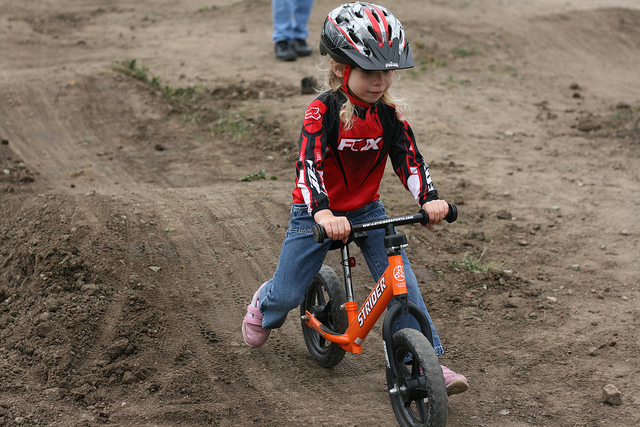On January 9, 2007, Ryan McFarland founded Strider Sports International, Inc. in Rapid City, S outh Dakota. Today, the company is known for its unorthodox—but extremely popular—bicycle models for children.
outh Dakota. Today, the company is known for its unorthodox—but extremely popular—bicycle models for children.
McFarland, who comes from a family of racing enthusiasts, was searching for a way to redesign the typical bicycle for his son. He believed that traditional training wheels, sprockets, chains, and even the pedals were adding unnecessary complexity to his child’s bike’s structure—making it difficult for his young, small son to navigate and control. After several revisions and prototypes, McFarland developed what is now known and sold as the STRIDER bike.
The STRIDER bike seeks to simplify the traditional bike model as much as possible. According to McFarland, “riding” a bike is a general term than can refer to many different types of movement. His account on the STRIDER website reads:
“If [the bike] didn’t have pedals, would it still be considered riding a bike? What defines riding? Again, the racer in me urged simplify, simplify, simplify. After all, downhill mountain bikers don’t pedal, road racers descending on a highway don’t pedal, and motorcyclists don’t pedal. They are all riding, so what do they all have in common? The ability to balance on two wheels and lean through regardless of what put them in motion. Pedaling is just one of the many means of propulsion.”
McFarland’s STRIDER model is a no-pedal balance bike, designed to teach toddlers and young children the fundamentals of balancing and steering without the complications of pedals and extra wheels. Children sit on the bike seat and begin to walk, or “stride,” while balancing their weight and learning to lean and keep the bike upright. By keeping their feet on the ground, children as young as 18 months are able to practice what it feels like to ride a “real” bicycle as they walk, run, and propel themselves across various landscapes.
The STRIDER website offers several tips on how to teach your children to ride their STRIDER bike at home:
- Adjust the bike to fit your child: Just as is the case with traditional bicycles, STRIDER bikes need to be properly adjusted. Adjust the saddle height so that your child can stand over the seat with their feet flat on the ground. Adjust the handlebars accordingly, and adjust the bike regularly to accommodate your child’s growth.
- Be a cheerleader, not a coach: Encourage your children to spend time with their STRIDER bike and do not try to dictate how they ride. Experimentation is part of the balancing and learning process.
- Let your child set their own pace: If your child seems insecure when they first interact with their STRIDER bike, give them space and let them practice. It may take a little while before young children learn to trust gravity and become comfortable riding.
- Support the child, not the bike: Do not hold onto the bike to keep it from tipping—even though that is your instinct! Your child must learn, without training wheels and without your help, how to keep their STRIDER bike from tipping.
 STRIDER bikes are not meant to be used forever, rather, they are a transitional tool for children until they are ready to make the shift to a bike with pedals. These no-pedal beginner bikes can be safer for young riders to use because by keeping their feet on the ground they gain greater control of the bike. STRIDER bikes come in a variety of sizes and colors. They are also widely used to help children with disabilities learn to ride. For more information on STRIDER bikes, visit their website.
STRIDER bikes are not meant to be used forever, rather, they are a transitional tool for children until they are ready to make the shift to a bike with pedals. These no-pedal beginner bikes can be safer for young riders to use because by keeping their feet on the ground they gain greater control of the bike. STRIDER bikes come in a variety of sizes and colors. They are also widely used to help children with disabilities learn to ride. For more information on STRIDER bikes, visit their website.
Photos Courtesy of Travis Swan and Creative Commons & Richard Masoner/Cyclelicious and Creative Commons.
